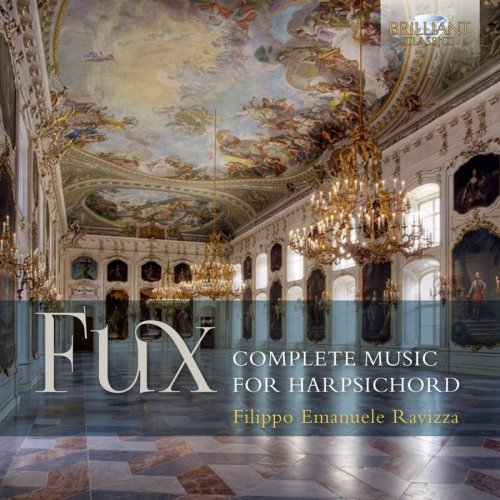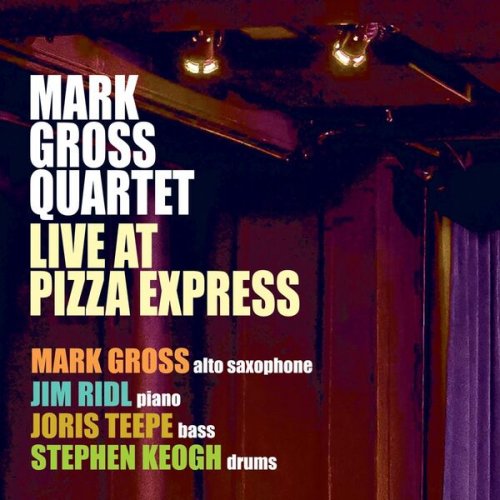Filippo Emanuele Ravizza - Fux: Complete Music for Harpsichord (2017) [CD Rip]

Artist: Filippo Emanuele Ravizza, Filippo Ravizza
Title: Johann Joseph Fux: Complete Music for Harpsichord
Year Of Release: 2017
Label: Brilliant Classics
Genre: Classical
Quality: FLAC (image + .cue, log, artwork)
Total Time: 2:18:07
Total Size: 838 MB
WebSite: Album Preview
Tracklist:Title: Johann Joseph Fux: Complete Music for Harpsichord
Year Of Release: 2017
Label: Brilliant Classics
Genre: Classical
Quality: FLAC (image + .cue, log, artwork)
Total Time: 2:18:07
Total Size: 838 MB
WebSite: Album Preview
CD1
[1]-[8] Partita No.1 in A minor E115
[9]-[14] Partita No.2 in F major, E116
[15]-[20] Partita No.3 in A major, K405
[21]-[26] Partita No.4 in G minor, E117
CD2
[1]-[9] Partita No.5 in G major, E70
[10]-[16] Capriccio in G minor, K404
[17] Ciaccona in D major, K403
[18] Harpeggio (Prelude & Fugue) in G major, E114/1
[19] Aria passaggiata in C major, E114/2
[20]-[31] 12 Menuets
Born in 1660 into a family of peasant farmers, Johann Joseph Fux died in 1741 as Kapellmeister at the Habsburg court in Vienna, a prestigious post that he had held for almost 30 years: an extraordinary rise in fortune and testament to both considerable gifts as a musician and, self-evidently, an inclination towards hard work and self-improvement.
He is best known now for the Gradus ad Parnassum. This monumental treatise was published in 1725 at the Emperor’s expense and quickly became an indispensable manual on counterpoint, studied and absorbed by generations of composers thereafter. However, its formidable reputation should not overshadow his talent as a creative musician, which is displayed here in five keyboard partitas, a colourful Capriccio and a set of 12 minuets as well as a trio of shorter pieces. In all of them may be heard – and enjoyed – a surprising degree of charm, grace and easefully written melody. Indeed, Fux’s achievement was a perfect balance between rational precision and feeling, artifice and spontaneity.
These new recordings by Filippo Emanuele Ravizzi have few rivals in the current catalogue. Ravizzi is a pupil of Bob van Asperen and Gustav Leonhardt: a distinguished pedigree, which brings a fine feeling both to the tripping, French-style dance rhythms of the partitas and to the potential for darker expressive coloration in the Capriccio and the long D major chaconne (not to be confused with a better-known G major work in the same form, composed by Fux for a chamber ensemble of strings). All these works, not forgetting the Aria passeggiata in C, with its masterful handling of counterpoint (as one might expect) became reference works for Bach and Handel in their turn. Anyone curious to hear the work of a formative figure in the Baroque period will take great pleasure from this set.
He is best known now for the Gradus ad Parnassum. This monumental treatise was published in 1725 at the Emperor’s expense and quickly became an indispensable manual on counterpoint, studied and absorbed by generations of composers thereafter. However, its formidable reputation should not overshadow his talent as a creative musician, which is displayed here in five keyboard partitas, a colourful Capriccio and a set of 12 minuets as well as a trio of shorter pieces. In all of them may be heard – and enjoyed – a surprising degree of charm, grace and easefully written melody. Indeed, Fux’s achievement was a perfect balance between rational precision and feeling, artifice and spontaneity.
These new recordings by Filippo Emanuele Ravizzi have few rivals in the current catalogue. Ravizzi is a pupil of Bob van Asperen and Gustav Leonhardt: a distinguished pedigree, which brings a fine feeling both to the tripping, French-style dance rhythms of the partitas and to the potential for darker expressive coloration in the Capriccio and the long D major chaconne (not to be confused with a better-known G major work in the same form, composed by Fux for a chamber ensemble of strings). All these works, not forgetting the Aria passeggiata in C, with its masterful handling of counterpoint (as one might expect) became reference works for Bach and Handel in their turn. Anyone curious to hear the work of a formative figure in the Baroque period will take great pleasure from this set.

![Demo Rumudo - Second Nature (2025) [Hi-Res] Demo Rumudo - Second Nature (2025) [Hi-Res]](https://www.dibpic.com/uploads/posts/2025-12/1765883076_cover.jpg)


![Bryan Ferry - Bitter-Sweet (2018) [Hi-Res] Bryan Ferry - Bitter-Sweet (2018) [Hi-Res]](https://www.dibpic.com/uploads/posts/2018-11/1543491501_folder.jpg)
![Tomasz Stańko - Unit (Polish Radio Sessions vol. 2/6) (2025) [Hi-Res] Tomasz Stańko - Unit (Polish Radio Sessions vol. 2/6) (2025) [Hi-Res]](https://www.dibpic.com/uploads/posts/2025-12/1765790300_cover.jpg)


![Mark Northam - More Music From The Pixar Films For Solo Piano (2025) [Hi-Res] Mark Northam - More Music From The Pixar Films For Solo Piano (2025) [Hi-Res]](https://img.israbox.com/img/2025-12/17/qc8ci6ocl25zt4m9ojnjn3k2k.jpg)